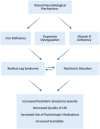Prevalence and correlates of restless leg syndrome in psychiatric outpatients in Lebanon
- PMID: 40781131
- PMCID: PMC12334753
- DOI: 10.1038/s41598-025-15036-2
Prevalence and correlates of restless leg syndrome in psychiatric outpatients in Lebanon
Abstract
Restless Legs Syndrome (RLS) is a prevalent yet underdiagnosed neurological disorder that significantly affects quality of life. It is commonly associated with psychiatric conditions, particularly depression and anxiety. Epidemiological data on RLS prevalence among psychiatric populations are limited and virtually absent in Lebanon. This study estimated RLS prevalence among psychiatric outpatients and assessed its impact on sleep quality, daytime sleepiness, anxiety, and depression, comparing findings to international literature. In this cross-sectional study, adult psychiatric outpatients were screened using International Restless Legs Syndrome Study Group (IRLSSG) criteria. Additional questionnaires included the Pittsburgh Sleep Quality Index (PSQI), Epworth Sleepiness Scale (ESS), Patient Health Questionnaire-9(PHQ-9), and Generalized Anxiety Disorder-7(GAD-7). Bivariate analysis compared patients with and without RLS. Multivariate regressions were utilized to adjust for potential confounders. Of 130 participants 25.4% had RLS. These patients showed significantly poorer sleep (PSQI = 11.18vs.8.10, p = 0.002), more depressive symptoms(PHQ-9 = 15.52vs.9.88,p < 0.001), and greater anxiety(GAD-7 = 15.26vs.9.51,p < 0.001), however, no significant difference was found in daytime sleepiness (ESS = 8.42vs.7.63,p = 0.405 ). RLS was significantly associated with suicidal ideation(p < 0.001). Correlation analysis revealed significant associations between RLS severity and both sleep disruption and psychiatric symptom severity. In conclusion, RLS is highly prevalent among psychiatric outpatients in Lebanon and is strongly associated with worse mental health and increased suicidal ideation.
Keywords: Anxiety; Depression; Lebanon; Psychiatric outpatients; RLS; Sleep disturbance.
© 2025. The Author(s).
Conflict of interest statement
Declarations. Competing interests: The authors declare no competing interests.
Figures
Similar articles
-
A comparative study of depressive and anxiety symptoms, insomnia, and sleepiness in patients with obstructive sleep apnea, restless legs syndrome, or both (CO-ROSA): preliminary findings from a retrospective study.Int Clin Psychopharmacol. 2025 Sep 1;40(5):275-280. doi: 10.1097/YIC.0000000000000571. Epub 2024 Dec 23. Int Clin Psychopharmacol. 2025. PMID: 39704028
-
Transcutaneous electric nerve stimulation in restless leg syndrome with cirrhosis: a pilot study.Expert Rev Med Devices. 2025 Jul;22(7):757-765. doi: 10.1080/17434440.2025.2508872. Epub 2025 May 20. Expert Rev Med Devices. 2025. PMID: 40391712 Clinical Trial.
-
Interventions for chronic kidney disease-associated restless legs syndrome.Cochrane Database Syst Rev. 2016 Nov 7;11(11):CD010690. doi: 10.1002/14651858.CD010690.pub2. Cochrane Database Syst Rev. 2016. PMID: 27819409 Free PMC article.
-
Prevalence of Restless Leg Syndrome and Its Association With Iron Deficiency in Patients With Chronic Kidney Disease: A Cross-Sectional Observational Study.Cureus. 2025 Jun 17;17(6):e86188. doi: 10.7759/cureus.86188. eCollection 2025 Jun. Cureus. 2025. PMID: 40677478 Free PMC article.
-
Iron for restless legs syndrome.Cochrane Database Syst Rev. 2012 May 16;5(5):CD007834. doi: 10.1002/14651858.CD007834.pub2. Cochrane Database Syst Rev. 2012. Update in: Cochrane Database Syst Rev. 2019 Jan 04;1:CD007834. doi: 10.1002/14651858.CD007834.pub3. PMID: 22592724 Free PMC article. Updated.
References
-
- Walters, A. S. Toward a better definition of the restless legs syndrome. The international restless legs syndrome study group. Mov. Disord. 10 (5), 634–642 (1995). - PubMed
MeSH terms
LinkOut - more resources
Full Text Sources
Medical


